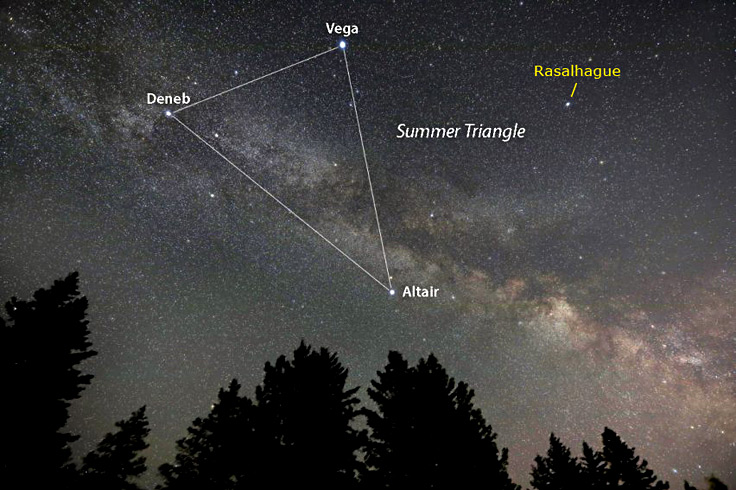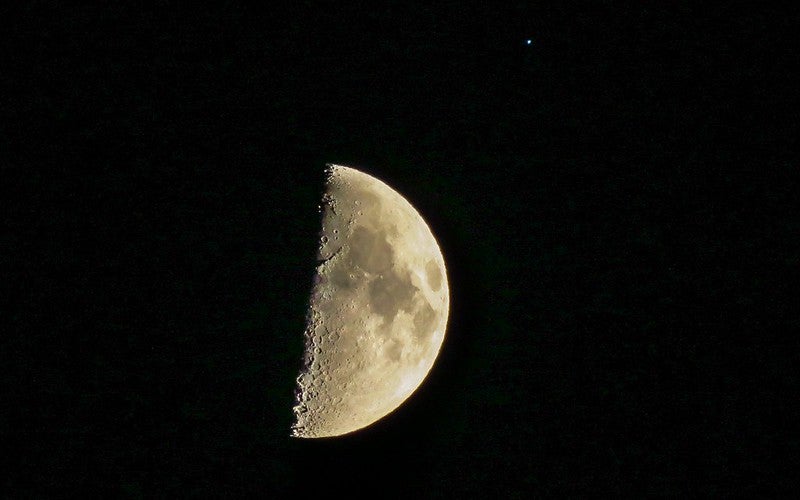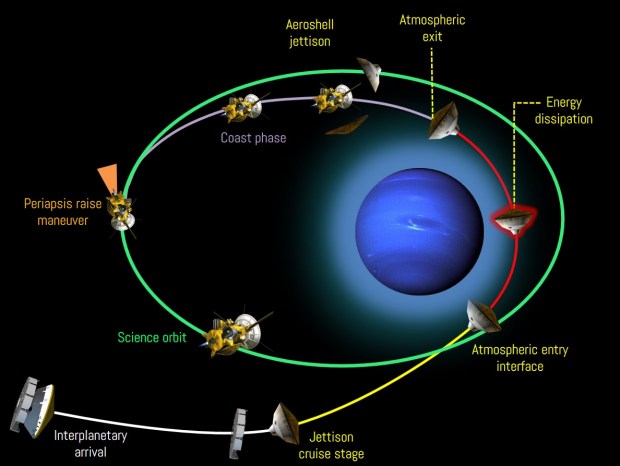FRIDAY, JULY 19
■ The nearly full Moon tonight shines in the handle of the Sagittarius Teapot. The rest of the Teapot is to the right. Cover the Moon with your fingertip to help reveal the stars.
SATURDAY, JULY 20
■ Full Moon this evening and Sunday evening. The Moon is exactly full at 6:16 a.m. Sunday morning EDT, nearly splitting the difference between the two evenings.
Tonight the Moon rides low across the sky between the Sagittarius Teapot to its right and the dim boat shape of Capricornus to its left (which will be hard to piece out through the moonlight).
SUNDAY, JULY 21
■ The low Moon this evening forms a huge, nearly vertical line with Altair about three fists above it and Vega the same distance above Altair, near the zenith.
■ Look a finger-width at arm’s length above Altair for its eternal little sidekick Tarazed (Gamma Aquilae), a modest magnitude 2.7 compared to Altair’s showy 0.7. But looks are deceiving. Altair appears so bright because it’s one of our near stellar neighbors, just 17 light-years away. Tarazed is an orange giant star about 380 light-years farther in the background. It’s 170 times as luminous as Altair!
MONDAY, JULY 22
■ Starry Scorpius is sometimes called “the Orion of Summer” — for its brightness, its blue-white giant stars, and its prominent red supergiant (Antares in the case of Scorpius, Betelgeuse for Orion). But Scorpius passes a lot lower across the southern sky than Orion does, for those of us at mid-northern latitudes. That means it has only one really good evening month: July.
Catch Scorpius due south just after dark now, before it starts to tilt lower toward the southwest.
TUESDAY, JULY 23
■ We’re only a third of the way through summer (astronomical summer, that is), but already Cassiopeia is getting well up after dark. Look for its tilted W pattern in the north-northeast.
High above it is dimmer Cepheus, weak in the moonlight. Below it, the head of Perseus is on the rise. The farther north you live the higher they all will appear.
WEDNESDAY, JULY 24
■ Low in the northwest or north at the end of these long summer twilights, would you recognize noctilucent clouds if you saw them? They’re the most astronomical of all cloud types, what with their extreme altitude and, sometimes, their formation on meteoric dust particles. And they’re fairly rare — though becoming more common in recent years as the atmosphere changes. See Bob King’s Nights of Noctilucent Clouds.
THURSDAY, JULY 25
■ Fourth star of the Summer Triangle? The next-brightest star near the Summer Triangle, if you want to turn it into a quadrilateral, is Rasalhague (Alpha Ophiuchi), the head of Ophiuchus. Look high southeast after dark, and the scene will be like this:
■ Late this evening, the waning gibbous Moon rises with yellowish Saturn glowing a few degrees to its right.
FRIDAY, JULY 26
■ Week by week, Venus is edging up in the west through the afterglow of sunset. Fading Mercury soon drops down. And can you make out fainter, twinkly Regulus near Mercury? See below.

SATURDAY, JULY 27
■ With the advance of summer, the Sagittarius Teapot, in the south after dark now, is tilting to pour from its spout to the right. The Teapot will tilt farther and farther for the rest of the summer and into early fall — or for much of the night if you stay out late.
SUNDAY, JULY 28
■ The tail of Scorpius is at its best low due south soon after dark. Find it a fist at arm’s length or less to the lower right of the Teapot’s spout. And/or about a fist and a half at arm’s length lower left of Antares. How low this scene will appear depends on how far north or south you live: the farther south, the higher.
Spot the two stars especially close together in the tail. These are Lambda and fainter Upsilon Scorpii, known as the Cat’s Eyes. They’re canted at an angle; the cat has a bleary eye and is tilting his head to the right. Lambda is brighter than Upsilon; they’re magnitudes 1.6 and 2.6. Both are blue-white supergiants, 700 and 500 light years away, respectively. Yes, the nearer one is fainter.
Between the Cat’s Eyes and the Teapot’s spout are the open star clusters M6 and especially M7, showy in binoculars.
Also: A line through the Cat’s Eyes points west (right) by nearly a fist toward Mu Scorpii, a much tighter pair known as the Little Cat’s Eyes. They’re oriented almost exactly the same way as Lambda and Upsilon, but they’re only 0.1° apart; use binoculars. They too are not a true binary: They’re 800 and 500 light-years away, respectively. Again, the fainter one is nearer.
This Week’s Planet Roundup
Mercury and Venus are deep in the afterglow of sunset, and this week fainter Regulus is down there too, passing Mercury. Use binoculars or a telescope’s lowest power to scan just above the west-northwest horizon starting about 20 minutes after sunset.
Venus is the lowest, but it may be the first you pick up because it’s by far the brightest, magnitude –3.9.
Then try for Mercury, fading from magnitude +0.2 to +0.7 this week, about 12° to Venus’s right and a little higher.
And Regulus, a mere magnitude +1.4? On Friday the 19th it’s 5.6° to Mercury’s upper left. They reach conjunction on the 25th, with Regulus now 2.2° to Mercury’s upper right.
You’ll need not only a flat WNW horizon and very clear air, but a readiness to come away empty-handed. This is a challenge project!
Mars and Jupiter (magnitudes +0.9 and –2.1, respectively, in Taurus) rise by about 1 or 2 a.m. Mars shines upper right of bright Jupiter. Watch their separation shrink from 13° to 9° this week. The Pleiades are above Mars, and Aldebaran is below the two planets. The array is much higher in the east by the time dawn overtakes it.
Saturn (magnitude +1.0, near the Aquarius-Pisces border) rises in the east soon after the end of twilight. Watch for it to come up lower right of the Great Square of Pegasus, which is balancing on one corner. The Square’s top-right edge points diagonally down almost at Saturn, two fists at arm’s length away.
Saturn is at its highest in the south, in the steadiest atmospheric seeing for a telescope, just before the first light of dawn. And the seeing often steadies down as dawn advances.

Uranus (magnitude 5.8, at the Aries-Taurus border) is several degrees to the upper right of Mars in the morning sky. You’ll need a good finder chart to identify it.
Neptune (a tougher magnitude 7.9, in Pisces) is 11° east of Saturn before dawn begins. Again you’ll need a finder chart.
All descriptions that relate to your horizon — including the words up, down, right, and left — are written for the world’s mid-northern latitudes. Descriptions and graphics that also depend on longitude (mainly Moon positions) are for North America.
Eastern Daylight Time (EDT) is Universal Time minus 4 hours. UT is also known as UTC, GMT, or Z time.
Want to become a better astronomer? Learn your way around the constellations. They’re the key to locating everything fainter and deeper to hunt with binoculars or a telescope.
This is an outdoor nature hobby. For a more detailed constellation guide covering the whole evening sky, use the big monthly map in the center of each issue of Sky & Telescope, the essential magazine of astronomy.
Once you get a telescope, to put it to good use you’ll need a much more detailed, large-scale sky atlas (set of charts). The basic standard is the Pocket Sky Atlas (in either the original or Jumbo Edition), which shows all stars to magnitude 7.6.

Next up is the larger and deeper Sky Atlas 2000.0, plotting stars to magnitude 8.5; nearly three times as many. (It’s currently out of print.) The next up are the even larger Interstellarum atlas (stars to magnitude 9.5) or Uranometria 2000.0 (stars to mag 9.75). And read How to Use a Star Chart with a Telescope. It applies just as much to charts on your phone or tablet as to charts on paper.
You’ll also want a good deep-sky guidebook. A beloved old classic is the three-volume Burnham’s Celestial Handbook. An impressive more modern one is the big Night Sky Observer’s Guide set (2+ volumes) by Kepple and Sanner. The top of the hill for total astro-geeks is the Annals of the Deep Sky series, currently at 10 volumes as it slowly works forward through the constellations alphabetically. So far it’s only up to F.
Can computerized telescopes replace charts? Not for beginners I don’t think, and not for scopes on mounts and tripods that are less than top-quality mechanically. Unless, that is, you prefer spending your time getting finicky technology to work rather than learning the sky. And as Terence Dickinson and Alan Dyer say in their Backyard Astronomer’s Guide, “A full appreciation of the universe cannot come without developing the skills to find things in the sky and understanding how the sky works. This knowledge comes only by spending time under the stars with star maps in hand and a curious mind.” Without these, “the sky never becomes a friendly place.”
If you do get a computerized scope, make sure its drives can be disengaged so you can swing it around and point it readily by hand when you want to, rather than only slowly by the electric motors (which eat batteries).
However, finding faint telescopic objects the old-fashioned way with charts isn’t simple either. Learn the essential tricks at How to Use a Star Chart with a Telescope.
![]() Audio sky tour. Out under the evening sky with your
Audio sky tour. Out under the evening sky with your
earbuds in place, listen to Kelly Beatty’s monthly
podcast tour of the naked-eye heavens above. It’s free.
“The dangers of not thinking clearly are much greater now than ever before. It’s not that there’s something new in our way of thinking, it’s that credulous and confused thinking can be much more lethal in ways it was never before.”
— Carl Sagan, 1996
“Facts are stubborn things.”
— John Adams, 1770




